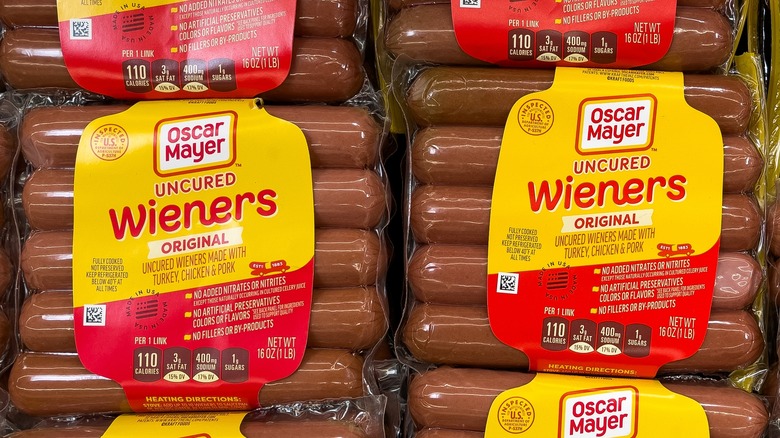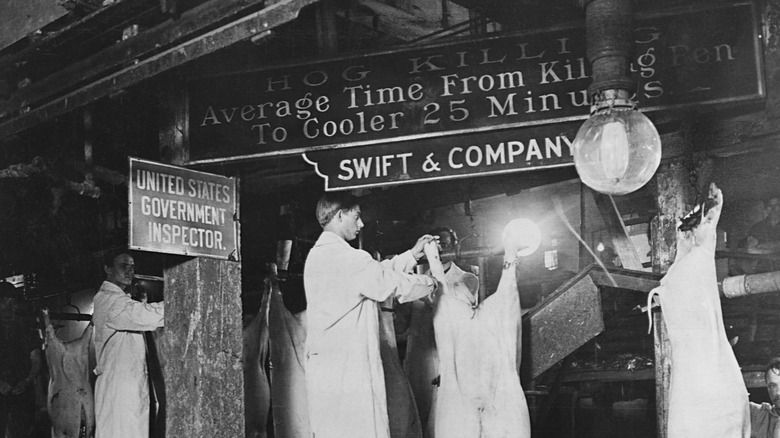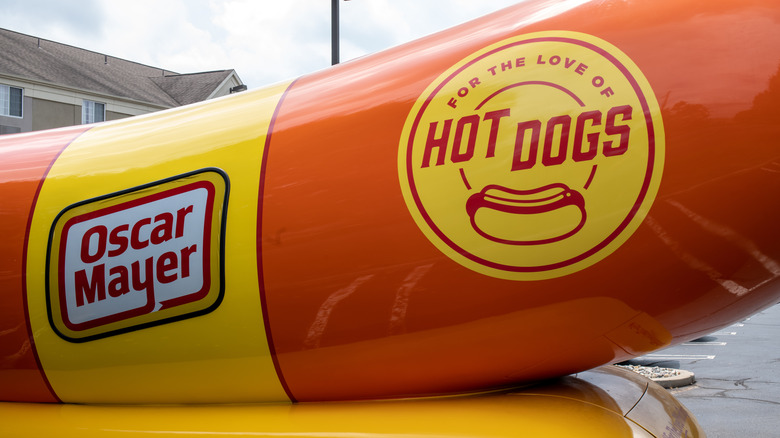How That Iconic Yellow Band Became A Part Of Oscar Mayer's Logo
Oscar Mayer is one of the most iconic meat producers in the U.S. Though its hot dogs now rank on the lower end of possible deli options, now that gourmet meat items are available in pretty much any grocery store, no company has much greater brand recognition than the Big Oscar. From its impossible-to-remove earworm of a jingle (sorry that it's in your head now) to their signature Wienermobile (now the "Frankmobile") to the yellow band that makes up part of its packaging and the company's logo, everybody knows Oscar Mayer, whether you buy its products or not.
But where did that yellow strip of branding come from? It turns out that long before the theme song or the Wienermobile, the yellow band was quite possibly the greatest driving force behind Oscar Mayer's success — and the maker's mark of its quality. To understand why, it helps to know the state of the American meat industry when Oscar Mayer was first getting its start.
Oscar Mayer stood out early for quality
The meat industry Oscar Mayer stepped into when he took over the Kolling Meat Market with his brother Gottfried in 1883 was very different from modern standards. Commercial refrigeration did exist at that point (it was first initiated in 1856 and the meat-packing industry was one of its first applications). But the quality of the time was a world away from what we know today. Food and safety inspections weren't mandatory until 1890, but still conditions were deplorable, as described graphically in 1905 by Upton Sinclair in his landmark book "The Jungle" about the Chicago meat-packing industry.
This, though, is where Mayer shone. In 1904, the company took the name Edelweiss (Oscar F. Mayer & Bro. was incorporated later in 1911), which was unusual because branding was rare back then. But the brothers wanted to stand out as a mark of quality among their competitors. After Sinclair's book came out, they leaned into his story and became one of the first companies to volunteer for precise government inspections and ensure customers got the best possible meat.
But they had another problem: Nobody could tell which hot dogs were theirs. This is where the yellow band came in.
The yellow band helped customers identify Oscar Mayer hot dogs
It seems bizarre to think of now, but in the early 20th century hot dogs weren't sold in individual packages at retailers. Instead, pork products were typically sold in big barrels, so wieners from all sources were mixed together. This meant you had quality dogs next to terrible ones without knowing the good from the bad.
The yellow band was the company's solution. In 1929, leaning heavily into its reputation for producing good products, Oscar Mayer began individually wrapping its hot dogs with distinctive yellow bands so that customers would know which was theirs — and every band featured a stamp declaring how its quality had been approved by government inspection. It was a genius move: Even though the yellow band increased the upfront materials and labor costs of producing the hot dogs — with extra packaging and time spent on branding every product — customers soon began actively seeking out Oscar Mayer. It created brand loyalty at a time when that didn't exist in the meat industry.
It was an easy step from there to make the yellow band part of its logo. After all, it was already what the company was known for. Truly, Oscar Mayer owes a large part of its success to that yellow band.


